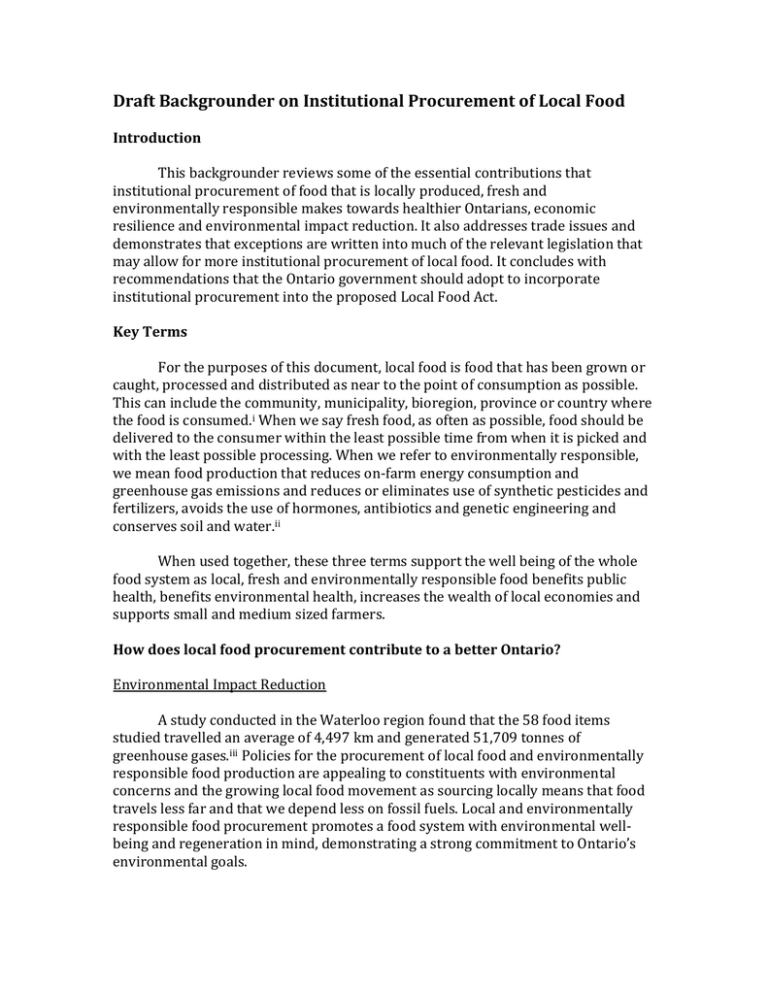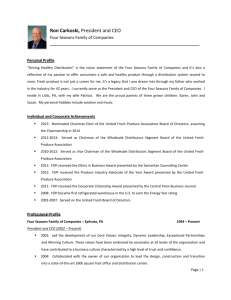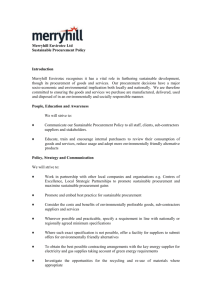Draft Backgrounder on Institutional Procurement of
advertisement

Draft Backgrounder on Institutional Procurement of Local Food Introduction This backgrounder reviews some of the essential contributions that institutional procurement of food that is locally produced, fresh and environmentally responsible makes towards healthier Ontarians, economic resilience and environmental impact reduction. It also addresses trade issues and demonstrates that exceptions are written into much of the relevant legislation that may allow for more institutional procurement of local food. It concludes with recommendations that the Ontario government should adopt to incorporate institutional procurement into the proposed Local Food Act. Key Terms For the purposes of this document, local food is food that has been grown or caught, processed and distributed as near to the point of consumption as possible. This can include the community, municipality, bioregion, province or country where the food is consumed.i When we say fresh food, as often as possible, food should be delivered to the consumer within the least possible time from when it is picked and with the least possible processing. When we refer to environmentally responsible, we mean food production that reduces on-farm energy consumption and greenhouse gas emissions and reduces or eliminates use of synthetic pesticides and fertilizers, avoids the use of hormones, antibiotics and genetic engineering and conserves soil and water.ii When used together, these three terms support the well being of the whole food system as local, fresh and environmentally responsible food benefits public health, benefits environmental health, increases the wealth of local economies and supports small and medium sized farmers. How does local food procurement contribute to a better Ontario? Environmental Impact Reduction A study conducted in the Waterloo region found that the 58 food items studied travelled an average of 4,497 km and generated 51,709 tonnes of greenhouse gases.iii Policies for the procurement of local food and environmentally responsible food production are appealing to constituents with environmental concerns and the growing local food movement as sourcing locally means that food travels less far and that we depend less on fossil fuels. Local and environmentally responsible food procurement promotes a food system with environmental wellbeing and regeneration in mind, demonstrating a strong commitment to Ontario’s environmental goals. Economic Resilience If procurement policies support local production, increased financial resources remain in the local economy and grow through a process known as the multiplier effect – the local economic activity that is triggered by the purchase of an item.iv The more a dollar circulates in a defined region, and the faster it circulates, the more income, wealth and jobs it creates.v For example, it is estimated that if every household in Ontario spent $10 a week on local food, there would be an additional $2.4 billion in the local economy at the end of the year and 10,000 new jobs would be created.vi This can have significant impacts in the revitalization of isolated and currently vulnerable areas as well as improving the incomes of local producers.vii Public Health Procurement policies for fresh, local food increase access to fresh food for the populations within public institutions such as school children and those recovering from illnesses. When these populations consume fresh, local food it may reduce future government costs such as those incurred by childhood obesity and diabetes and long and frequent hospital stays. Dieticians of Canada report that well-nourished children are better able to learn in school, be active, and maintain a healthy lifestyle into adulthood.viii And yet only 14% of children between 9 and 12 years of age eat the recommended daily serving of fruit and vegetables.ix With childhood obesity and diet-related illness on the rise, schools are in a unique position to reverse this trend. By providing fresh, healthy and locally-sourced foods, schools may set life-long precedents for proper nutrition and healthy lifestyles. Ontario’s future economic performance, productivity and health care costs depend on how well children learn in school and on what habits they develop. For this reason, fresh, local food procurement in schools appeals to a variety of voters including parents, educators, health practitioners, and advocacy groups who work to combat child poverty and food insecurity. The Ontario health care sector provides approximately 115 million meals every year and less than a quarter of this food is from Ontario.x These public tax dollars currently being spent on highly-processed, imported food could be buying fresh local food and being recycled back into the provincial economy. Today, longterm care facilities are to spend $7.60 per patient per day on food, which St. Joseph’s hospital in Guelph has managed to maintain making 75% of their food from scratch and sourcing 20% locally.xi Hospital and long-term care facility patients need fresh food to boost their morale, their health, their healing time and to act as a model of healthy eating outside of the facility. Interactions with Trade Agreements Trade agreements can appear to present barriers to the procurement of local food. However, upon closer examination there are many exemptions that allow and have allowed public institutions in Ontario to source more food locally. Firstly, though Canada is a signatory to The World Trade Organization’s Agreement on Government Procurement and the North American Free Trade Agreement, neither applies to provincial or municipal institutional procurement.xii The province is however subject to the Agreement on Internal Trade (AIT), which stipulates that all Canadian suppliers have the right to bid on public-sector contracts over a certain value. As well, the Discriminatory Business Practices Act prohibits granting preference to suppliers based on geographic location. However, as long as institutions word their Requests for Proposal strategically, these are still broad enough to allow them to source more food locally, as the University of Toronto has done.xiii For example, the AIT allows for an exception to the procurement rules if a party can demonstrate “that the purpose of the measure is to achieve a legitimate objective” such as protection of the environment, protection of human health or affirmative action programs for disadvantaged groups.xiv Certainly the objective of the procurement of fresh and/or environmentally responsible and/or local food fits into this definition. Another agreement that provides space for local procurement is the General Agreement on Tariffs and Trade, in which Article III indicates that governments cannot apply taxes or other barriers to imported products to support their domestic economy. However, Paragraph 8 allows for exemptions for government agencies purchasing food for government purposes and not for resale.xv As a final example, the World Trade Organization’s Agreement on Agriculture has a Green Box (or environmental) category under which support is permitted.xvi Therefore it is feasible to mark local and environmentally responsible programming under this category as it can generate significant environmental impact reduction. Recommendations Develop fresh, local and environmentally responsible food procurement policies for public institutions Develop these procurement targets and build these requirements into contracts with food suppliers in Broader Public Sector institutions. In particular, increase the availability of fresh, local and environmentally responsible foods in childcare, preschools, schools, colleges, universities, long term care facilities, hospitals, corrections facilities, recreation centres, government workplaces and other public facilities. Provide incentives and training to enable public sector institutions to meet the procurement targets. The Ontario government should publish definitions of food that is fresh, local and environmentally responsible as well as tracking mechanisms for institutions to measure its use. Increase the amount of fresh, local and environmentally responsible food in hospitals and long-term care facilitiesxvii The Ministry of health and long-term care (MOHLTC) should feature food on its website, thereby recognizing food as both a treatment and prevention tool. Increase the MOHLTC food subsidy, increase the percentage of facilities’ budgets devoted to the food service department and adjust Ontario’s food safety regulations to facilitate local procurement. Increase the amount of local, fresh and environmentally responsible food in daycares, schools, colleges and universities Develop purchasing policies in these institutions as a means to increase child and youth access to fresh food. Establish and maintain children’s gardens and composters in schools. Continue and expand funds for the Student Nutrition Program and develop a universal Student Nutrition Program for the province. Require all new schools to have a kitchen and cafeteria. Engage OMAFRA Continue and expand the Broader Public Sector Investment Fund and ensure a portion of the fund is directed toward innovative new leading edge players in the BPS food sector as well as established food companies. Provide funding for soft infrastructure organizations that facilitate local food producers, processors and distributors in accessing the BPS market. Engage a third party to conduct local, fresh and environmentally responsible food certification. Develop markets for products rejected by supermarkets.xviii i Adapted from the definition of “local” by Local Food Plus. Available online: http://www.localfoodplus.ca/about/faqs#7. ii Adapted from the definition of “sustainable” by Local Food Plus. Available online: http://www.localfoodplus.ca/about/faqs#7. iii MacLeod, M. and Scott, J. 2007. “Local Food Procurement Policies: A Literature Review.” Nova Scotia: The Ecology Action Centre and the Nova Scotia Department of Energy. iv Swenson, D. 2009. “Investigating the Potential Economic Impacts of Local Foods for Southeast Iowa.” Ames, IA: Iowa State University. (Leopold Center for Sustainable Agriculture). v Shuman, M and Hoffer, D. 2007. “Leakage Analysis of the Martha’s Vineyard Economy: Increasing Prosperity through Greater Self-Reliance.” (Training and Development Corporation). vi Ogryzlo, L. 2012. “$10 Challenge, Billion Dollar Impact.” The Ontario Table. Available online: http://www.ontariotable.com/10-challenge-billion-dollar-impact/ vii MacLeod and Scott, 2007. viii Toronto Youth Food Policy Council. 2011. “Food Literacy in Education.” Research and Policy. ix Sustain Ontario. 2011. “Good Food Policies for Education.” Retrieved from: http://sustainontario.com/initiatives/policies/gfpps-sector/good-food-policies-for-education. Sustain Ontario. 2011. “Vote ON Food and Farming: FAQs.” Schwartz, D. 2012. “Hospital food ‘revolution’ takes root.” CBC News: Health. xii Baker, L. Campsie, P. and Rabinowicz, K. 2010. “Menu 2020: Ten Good Food Ideas for Ontario.” Metcalf Food Solutions. xiii Baker et al. 2010. xiv Carter-Whitney, M. 2008. “Bringing Local Food Home: Legal, Regulatory and Institutional Barriers to Local Food.” Toronto: Friends of the Greenbelt Occasional Paper Series. xv World Trade Organization. 1947. “The General Agreement on Tariffs and Trade.” WTO Legal Texts Online. xvi World Trade Organization. 1994. “Agreement on Agriculture.” Uruguay Round Agreement. WTO Legal Texts Online. xvii All recommendations in this section from: Padanyi, P., Kanetkar, V., Varangu, L., Wylie-Toal, B., Blay-Palmer, A. 2012. “Report on Food Provision in Ontario Hospitals and Long-Term Care Facilities: The Challenges and Opportunities of Incorporating Local Foods.” University of Guelph, The Ontario Ministry of Agriculture, Food and Rural Affairs Partnership Fund, and The Canadian Coalition for Green Health Care. xviii MacLeod and Scott, 2007. x xi








